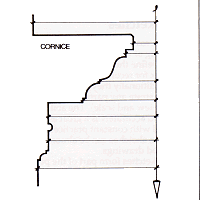
Figure 6
Measurement of detail by offsets from vertical plumb line. Corresponding vertical measurements from a level datum line are required to complete the view. Offset measurements can be taken from oblique lines as well.
MISCELLANEOUS TECHNIQUES
 Choice of Measuring Faces. The recorder should make a consistent choice of surfaces or edges to which measurements are taken. Measurement to the centreline of walls, windows or doors should be avoided. The usual conventions are: Choice of Measuring Faces. The recorder should make a consistent choice of surfaces or edges to which measurements are taken. Measurement to the centreline of walls, windows or doors should be avoided. The usual conventions are:
- walls and ceilings - to face of plaster or boarding
- window frames - interior face of frame
- door frames - face of door rebate (i.e., the face of the recess that the door fits into).
 Other conventions may be developed to deal with specific situations. They should be noted in the field sketches and should also be indicated as measuring faces on the detail drawings. In this way, the position of the detail is clearly represented with respect to the overall plan or grid system. Other conventions may be developed to deal with specific situations. They should be noted in the field sketches and should also be indicated as measuring faces on the detail drawings. In this way, the position of the detail is clearly represented with respect to the overall plan or grid system.
|
 |
 Method of Taking Dimensions. There are two basic methods of taking linear dimensions. Running measurements are taken by holding the zero end of the tape measure at a corner or "control point" and reading cumulative measurements to all points along the line. This method avoids the accumulation of small errors that can occur when incremental measurements of the component elements are summed. For overall plans and elevations, running measurements should be used as they are more accurate. It is nevertheless important to take enough incremental measurements during the field work to become familiar with the standard modules of construction that may exist. This method will help in identifying repetitive types of detail, such as types of windows and doors, joist spacings, etc. Method of Taking Dimensions. There are two basic methods of taking linear dimensions. Running measurements are taken by holding the zero end of the tape measure at a corner or "control point" and reading cumulative measurements to all points along the line. This method avoids the accumulation of small errors that can occur when incremental measurements of the component elements are summed. For overall plans and elevations, running measurements should be used as they are more accurate. It is nevertheless important to take enough incremental measurements during the field work to become familiar with the standard modules of construction that may exist. This method will help in identifying repetitive types of detail, such as types of windows and doors, joist spacings, etc.
 Dimension by Counting. When dealing with repetitive building components of fairly uniform size, such as brick courses, shingles and uniform boarding, it is convenient to take overall measurements and then to count the number of courses, boards, etc., within the space. This information can easily be plotted. Less accurate, but convenient, is the procedure of calculating heights by multiplying the average course height times the number of courses to obtain an overall height. This method is acceptable when great accuracy is not particularly important, such as in determining the height of chimneys above the roof. Dimension by Counting. When dealing with repetitive building components of fairly uniform size, such as brick courses, shingles and uniform boarding, it is convenient to take overall measurements and then to count the number of courses, boards, etc., within the space. This information can easily be plotted. Less accurate, but convenient, is the procedure of calculating heights by multiplying the average course height times the number of courses to obtain an overall height. This method is acceptable when great accuracy is not particularly important, such as in determining the height of chimneys above the roof.
|










